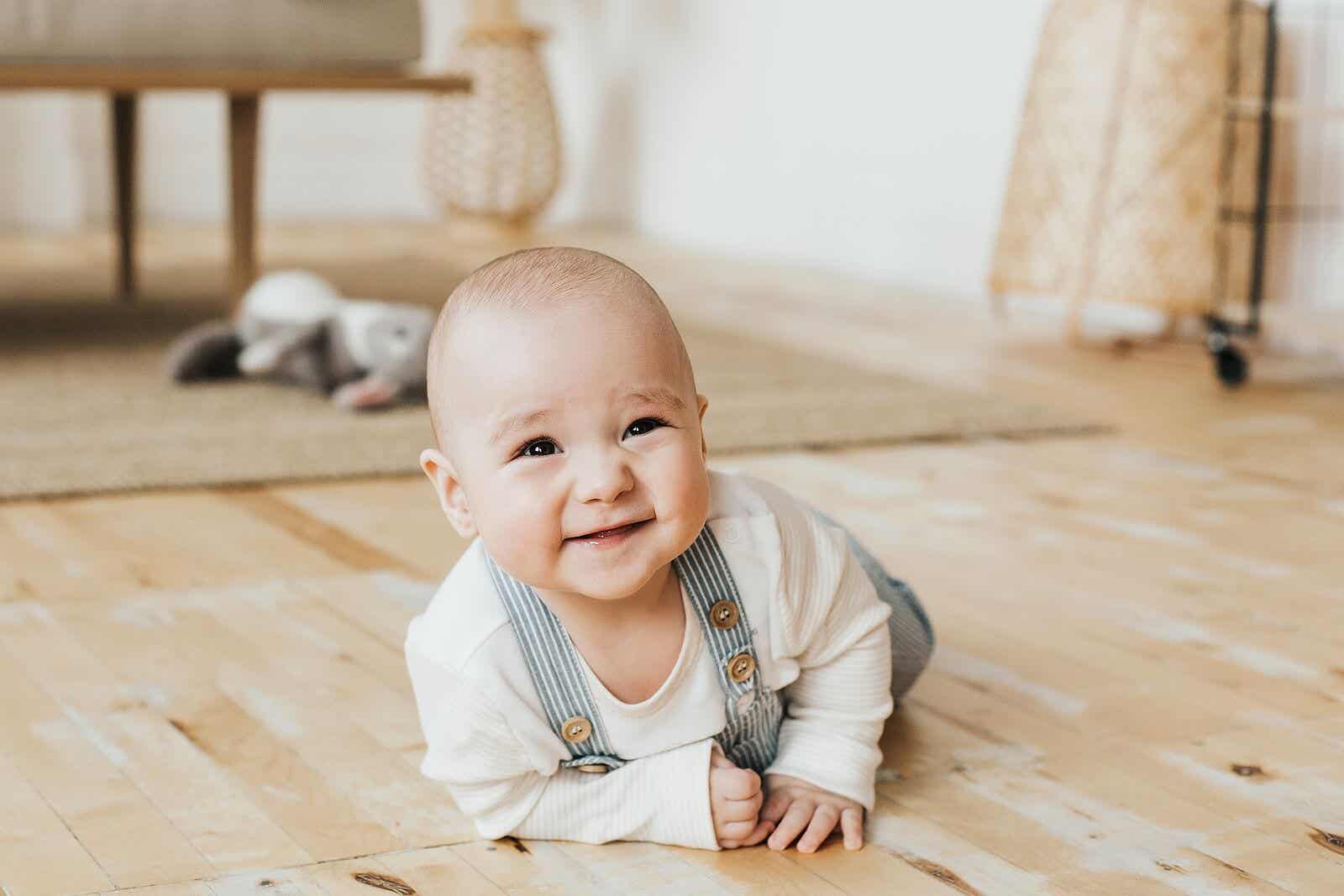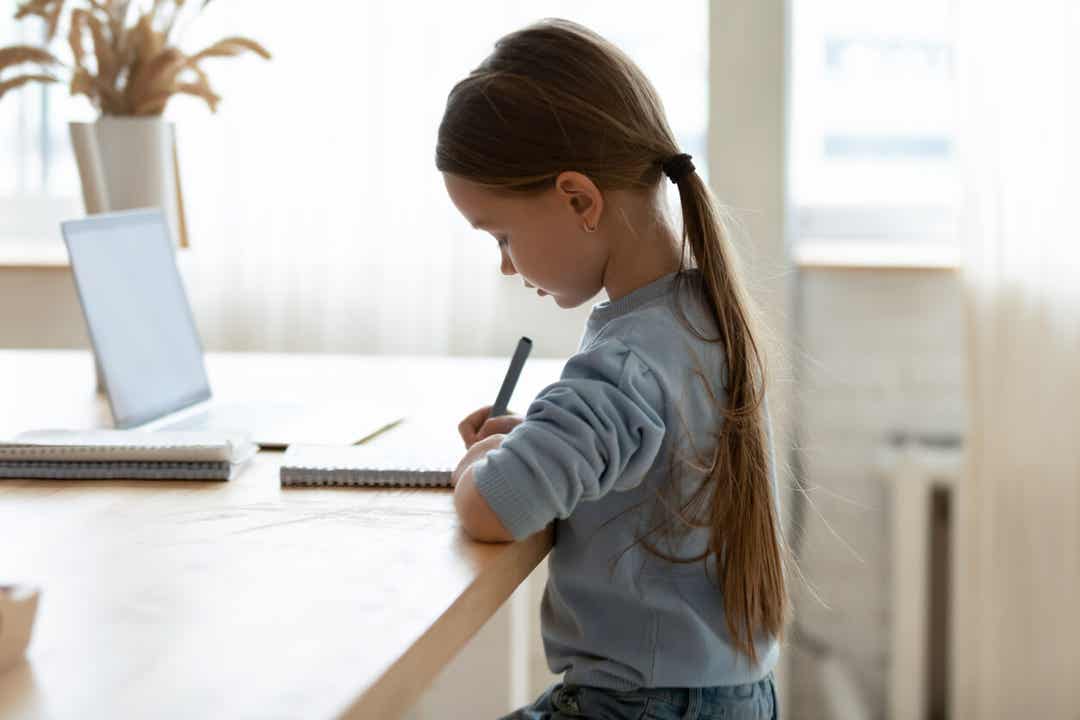4 Keys to Achieving Proper Postural Hygiene in Children


Written and verified by the physiotherapist Maria Elisa Lisotti Luppi
During early childhood, the child’s body develops at great speed. It’s the right time to observe, accompany, and educate them on how to take care of themselves. This in order to prevent possible vicious positions that may lead to future alterations. Healthy habits and free movement should be considered as the main axes to incorporate and maintain throughout life. These are some of the keys to achieve adequate postural hygiene in children.
Posture is the way in which we arrange and carry the different parts of the body. It’s determined by several factors, such as genetic and environmental ones. By adopting a postural attitude and repeating it over time, we obtain postural habits.
From here comes the importance of offering corporal education to children from an early age, due to the fact that, in the first years of life, the development of the central nervous system and the locomotor apparatus deepens.
The motor development of the child takes place in differentiated stages. In the first weeks of life, a child must straighten their head. This in order to be able to orient it voluntarily. From the first months onward, the child achieves greater muscular strength until they come to sit up and later crawl.
Around the age of one year, they’re able to stand up to begin to take their first steps. From the ages of two to five years old, they improve their walking coordination, motor skills, and knowledge of their own body. Here, we’ll explain the four keys to achieving adequate postural hygiene in children.
Four keys to achieving adequate postural hygiene in children

1. Teach the child healthy habits
From the moment a baby is born, it begins to adapt to the environment around it, as well as to its caregivers and their daily habits and activities. It’s from that moment when we must be aware of how adult behaviors influence the child’s development and of the importance of healthy habits in both.
The way we eat, how we relate to each other, how we move, etc., will directly influence the way the child will carry out the same activities. It’s an opportunity to offer healthy food that provides a good quality source of energy. In addition to building clear and simple communication, that adapts to the child, to better understand their needs at each stage. And, of course, transmitting the value of being physically active.
Exposure to screens is one of the most difficult issues to manage for many parents. It can be a major obstacle to achieving proper postural hygiene in children. The fact that they’re becoming more and more intrusive leads children to stay in front of screens for longer periods of time.
This causes them to maintain the same posture, without moving, for prolonged periods of time. This leads to habituating the child to more sedentary behavior.
2. Facilitate free movement in the child for an adequate postural hygiene
Exploration is one of the ways in which the child gets to know the world. For this, they need freedom of movement regarding their clothing, the shoes they wear (with bare feet as much as possible), and in the space in which they find themselves.
There are numerous devices on the market for positioning the little ones. These elements provide greater comfort for adults but take away important possibilities when it comes to the child’s movement.
This doesn’t mean that you should never use these devices but it does mean that you shouldn’t use them for long periods of time. The priority should be to use the floor, adapting it with the necessary elements to make it safe. On blankets or padded floors, with toys or elements for the child’s entertainment according to developmental stage. Always accompany and supervise the child, without leaving them alone.
3. Encourage the child to play
Play is another way in which children discover their environment and is the best way to learn. It’s a need that has different characteristics depending on the interests of the child, according to their developmental stage and environment.
Toys are a tool that allows learning while having fun. The child learns with their whole being, which allows them to develop their motor, emotional, and intellectual areas simultaneously. This favors the development of coordination, body scheme, and, therefore, postural awareness.
4. Provide children with multiple stimuli for a good postural hygiene
In the variety of activities lies the wealth of stimuli. And that’s why it’s important for caregivers to be able to register the child’s needs at each stage and adapt them to the objects and circumstances around the child.

Prevention is the best medicine
Postural alterations usually appear, or at least are detectable, around six to eight years of age, when the child starts primary school. By that time, biomechanical imbalances that could’ve been prevented with proper postural hygiene have already been established.
Among the most common ailments are scoliosis, hyperkyphosis, and hyperlordosis. These are different deviations of the spine. Treatments are lengthy and require an interdisciplinary team. All this affects the child’s quality of life and emotional wellbeing.
From the moment the child starts preschool, it’s important to protect their spine by using a backpack on both shoulders or with wheels, and that its weight does not exceed 10 percent of the child’s body weight. In the same way, furniture must be adequate and proportionate. This is when you need to make sure that little one’s sit in their chairs correctly.
Therefore, it’s key that you start teaching healthy habits, allow free movement, encourage play, and stimulate the child in several different ways from the first months of life in order to achieve proper postural hygiene. This will provide great benefits in their motor development, better muscular balance, and, consequently, healthier postural habits, and less predisposition to future alterations.
During early childhood, the child’s body develops at great speed. It’s the right time to observe, accompany, and educate them on how to take care of themselves. This in order to prevent possible vicious positions that may lead to future alterations. Healthy habits and free movement should be considered as the main axes to incorporate and maintain throughout life. These are some of the keys to achieve adequate postural hygiene in children.
Posture is the way in which we arrange and carry the different parts of the body. It’s determined by several factors, such as genetic and environmental ones. By adopting a postural attitude and repeating it over time, we obtain postural habits.
From here comes the importance of offering corporal education to children from an early age, due to the fact that, in the first years of life, the development of the central nervous system and the locomotor apparatus deepens.
The motor development of the child takes place in differentiated stages. In the first weeks of life, a child must straighten their head. This in order to be able to orient it voluntarily. From the first months onward, the child achieves greater muscular strength until they come to sit up and later crawl.
Around the age of one year, they’re able to stand up to begin to take their first steps. From the ages of two to five years old, they improve their walking coordination, motor skills, and knowledge of their own body. Here, we’ll explain the four keys to achieving adequate postural hygiene in children.
Four keys to achieving adequate postural hygiene in children

1. Teach the child healthy habits
From the moment a baby is born, it begins to adapt to the environment around it, as well as to its caregivers and their daily habits and activities. It’s from that moment when we must be aware of how adult behaviors influence the child’s development and of the importance of healthy habits in both.
The way we eat, how we relate to each other, how we move, etc., will directly influence the way the child will carry out the same activities. It’s an opportunity to offer healthy food that provides a good quality source of energy. In addition to building clear and simple communication, that adapts to the child, to better understand their needs at each stage. And, of course, transmitting the value of being physically active.
Exposure to screens is one of the most difficult issues to manage for many parents. It can be a major obstacle to achieving proper postural hygiene in children. The fact that they’re becoming more and more intrusive leads children to stay in front of screens for longer periods of time.
This causes them to maintain the same posture, without moving, for prolonged periods of time. This leads to habituating the child to more sedentary behavior.
2. Facilitate free movement in the child for an adequate postural hygiene
Exploration is one of the ways in which the child gets to know the world. For this, they need freedom of movement regarding their clothing, the shoes they wear (with bare feet as much as possible), and in the space in which they find themselves.
There are numerous devices on the market for positioning the little ones. These elements provide greater comfort for adults but take away important possibilities when it comes to the child’s movement.
This doesn’t mean that you should never use these devices but it does mean that you shouldn’t use them for long periods of time. The priority should be to use the floor, adapting it with the necessary elements to make it safe. On blankets or padded floors, with toys or elements for the child’s entertainment according to developmental stage. Always accompany and supervise the child, without leaving them alone.
3. Encourage the child to play
Play is another way in which children discover their environment and is the best way to learn. It’s a need that has different characteristics depending on the interests of the child, according to their developmental stage and environment.
Toys are a tool that allows learning while having fun. The child learns with their whole being, which allows them to develop their motor, emotional, and intellectual areas simultaneously. This favors the development of coordination, body scheme, and, therefore, postural awareness.
4. Provide children with multiple stimuli for a good postural hygiene
In the variety of activities lies the wealth of stimuli. And that’s why it’s important for caregivers to be able to register the child’s needs at each stage and adapt them to the objects and circumstances around the child.

Prevention is the best medicine
Postural alterations usually appear, or at least are detectable, around six to eight years of age, when the child starts primary school. By that time, biomechanical imbalances that could’ve been prevented with proper postural hygiene have already been established.
Among the most common ailments are scoliosis, hyperkyphosis, and hyperlordosis. These are different deviations of the spine. Treatments are lengthy and require an interdisciplinary team. All this affects the child’s quality of life and emotional wellbeing.
From the moment the child starts preschool, it’s important to protect their spine by using a backpack on both shoulders or with wheels, and that its weight does not exceed 10 percent of the child’s body weight. In the same way, furniture must be adequate and proportionate. This is when you need to make sure that little one’s sit in their chairs correctly.
Therefore, it’s key that you start teaching healthy habits, allow free movement, encourage play, and stimulate the child in several different ways from the first months of life in order to achieve proper postural hygiene. This will provide great benefits in their motor development, better muscular balance, and, consequently, healthier postural habits, and less predisposition to future alterations.
All cited sources were thoroughly reviewed by our team to ensure their quality, reliability, currency, and validity. The bibliography of this article was considered reliable and of academic or scientific accuracy.
- Chacón Borrego, Fátima, et al. “Educación e higiene postural en el ámbito de la Educación Física: Papel del maestro en la prevención de lesiones: Revisión sistemática.” (2018).
- Pardo Priante, Nazaret. “Como afectan las TICs en el cuerpo de los niños y el papel de la higiene postural. Propuesta de intervención en Educación Física.” (2019).
- Campo-Ternera, Lilia, et al. “Estilos de vida saludables de niños, niñas y adolescentes.” Salud Uninorte 33.3 (2017): 419-428.
- Vasquez Romero, Claudia Maria. “Análisis de riesgos posturales asociados al dolor de espalda en escolares y su prevención desde la higiene postural.” (2018).
- Yang, Le. Estudio de la influencia de la higiene postural y la ergonomía en el rendimiento académico. BS thesis. Universitat Politècnica de Catalunya, 2018.
- Mejía-Balcázar, Milton, Bélgica Aguilar-Aguilar, and Krupskaya Mejía-Baraja. “Hábitos posturales de riesgo para desarrollar hiperlordosis, cifosis y escoliosis en niños/as de 11 a 13 años.” CEDAMAZ 7.1 (2017).
- Rodríguez Torres, Ángel Freddy, et al. “Beneficios de la actividad física para niños y adolescentes en el contexto escolar.” Revista Cubana de Medicina General Integral 36.2 (2020).
This text is provided for informational purposes only and does not replace consultation with a professional. If in doubt, consult your specialist.








